Siyu Li
Hallucinating 360°: Panoramic Street-View Generation via Local Scenes Diffusion and Probabilistic Prompting
Jul 09, 2025Abstract:Panoramic perception holds significant potential for autonomous driving, enabling vehicles to acquire a comprehensive 360{\deg} surround view in a single shot. However, autonomous driving is a data-driven task. Complete panoramic data acquisition requires complex sampling systems and annotation pipelines, which are time-consuming and labor-intensive. Although existing street view generation models have demonstrated strong data regeneration capabilities, they can only learn from the fixed data distribution of existing datasets and cannot achieve high-quality, controllable panoramic generation. In this paper, we propose the first panoramic generation method Percep360 for autonomous driving. Percep360 enables coherent generation of panoramic data with control signals based on the stitched panoramic data. Percep360 focuses on two key aspects: coherence and controllability. Specifically, to overcome the inherent information loss caused by the pinhole sampling process, we propose the Local Scenes Diffusion Method (LSDM). LSDM reformulates the panorama generation as a spatially continuous diffusion process, bridging the gaps between different data distributions. Additionally, to achieve the controllable generation of panoramic images, we propose a Probabilistic Prompting Method (PPM). PPM dynamically selects the most relevant control cues, enabling controllable panoramic image generation. We evaluate the effectiveness of the generated images from three perspectives: image quality assessment (i.e., no-reference and with reference), controllability, and their utility in real-world Bird's Eye View (BEV) segmentation. Notably, the generated data consistently outperforms the original stitched images in no-reference quality metrics and enhances downstream perception models. The source code will be publicly available at https://github.com/Bryant-Teng/Percep360.
HierDAMap: Towards Universal Domain Adaptive BEV Mapping via Hierarchical Perspective Priors
Mar 10, 2025Abstract:The exploration of Bird's-Eye View (BEV) mapping technology has driven significant innovation in visual perception technology for autonomous driving. BEV mapping models need to be applied to the unlabeled real world, making the study of unsupervised domain adaptation models an essential path. However, research on unsupervised domain adaptation for BEV mapping remains limited and cannot perfectly accommodate all BEV mapping tasks. To address this gap, this paper proposes HierDAMap, a universal and holistic BEV domain adaptation framework with hierarchical perspective priors. Unlike existing research that solely focuses on image-level learning using prior knowledge, this paper explores the guiding role of perspective prior knowledge across three distinct levels: global, sparse, and instance levels. With these priors, HierDA consists of three essential components, including Semantic-Guided Pseudo Supervision (SGPS), Dynamic-Aware Coherence Learning (DACL), and Cross-Domain Frustum Mixing (CDFM). SGPS constrains the cross-domain consistency of perspective feature distribution through pseudo labels generated by vision foundation models in 2D space. To mitigate feature distribution discrepancies caused by spatial variations, DACL employs uncertainty-aware predicted depth as an intermediary to derive dynamic BEV labels from perspective pseudo-labels, thereby constraining the coarse BEV features derived from corresponding perspective features. CDFM, on the other hand, leverages perspective masks of view frustum to mix multi-view perspective images from both domains, which guides cross-domain view transformation and encoding learning through mixed BEV labels. The proposed method is verified on multiple BEV mapping tasks, such as BEV semantic segmentation, high-definition semantic, and vectorized mapping. The source code will be made publicly available at https://github.com/lynn-yu/HierDAMap.
TS-CGNet: Temporal-Spatial Fusion Meets Centerline-Guided Diffusion for BEV Mapping
Mar 04, 2025Abstract:Bird's Eye View (BEV) perception technology is crucial for autonomous driving, as it generates top-down 2D maps for environment perception, navigation, and decision-making. Nevertheless, the majority of current BEV map generation studies focusing on visual map generation lack depth-aware reasoning capabilities. They exhibit limited efficacy in managing occlusions and handling complex environments, with a notable decline in perceptual performance under adverse weather conditions or low-light scenarios. Therefore, this paper proposes TS-CGNet, which leverages Temporal-Spatial fusion with Centerline-Guided diffusion. This visual framework, grounded in prior knowledge, is designed for integration into any existing network for building BEV maps. Specifically, this framework is decoupled into three parts: Local mapping system involves the initial generation of semantic maps using purely visual information; The Temporal-Spatial Aligner Module (TSAM) integrates historical information into mapping generation by applying transformation matrices; The Centerline-Guided Diffusion Model (CGDM) is a prediction module based on the diffusion model. CGDM incorporates centerline information through spatial-attention mechanisms to enhance semantic segmentation reconstruction. We construct BEV semantic segmentation maps by our methods on the public nuScenes and the robustness benchmarks under various corruptions. Our method improves 1.90%, 1.73%, and 2.87% for perceived ranges of 60x30m, 120x60m, and 240x60m in the task of BEV HD mapping. TS-CGNet attains an improvement of 1.92% for perceived ranges of 100x100m in the task of BEV semantic mapping. Moreover, TS-CGNet achieves an average improvement of 2.92% in detection accuracy under varying weather conditions and sensor interferences in the perception range of 240x60m. The source code will be publicly available at https://github.com/krabs-H/TS-CGNet.
Proposing and solving olympiad geometry with guided tree search
Dec 14, 2024Abstract:Mathematics olympiads are prestigious competitions, with problem proposing and solving highly honored. Building artificial intelligence that proposes and solves olympiads presents an unresolved challenge in automated theorem discovery and proving, especially in geometry for its combination of numerical and spatial elements. We introduce TongGeometry, a Euclidean geometry system supporting tree-search-based guided problem proposing and solving. The efficient geometry system establishes the most extensive repository of geometry theorems to date: within the same computational budget as the existing state-of-the-art, TongGeometry discovers 6.7 billion geometry theorems requiring auxiliary constructions, including 4.1 billion exhibiting geometric symmetry. Among them, 10 theorems were proposed to regional mathematical olympiads with 3 of TongGeometry's proposals selected in real competitions, earning spots in a national team qualifying exam or a top civil olympiad in China and the US. Guided by fine-tuned large language models, TongGeometry solved all International Mathematical Olympiad geometry in IMO-AG-30, outperforming gold medalists for the first time. It also surpasses the existing state-of-the-art across a broader spectrum of olympiad-level problems. The full capabilities of the system can be utilized on a consumer-grade machine, making the model more accessible and fostering widespread democratization of its use. By analogy, unlike existing systems that merely solve problems like students, TongGeometry acts like a geometry coach, discovering, presenting, and proving theorems.
Trans4D: Realistic Geometry-Aware Transition for Compositional Text-to-4D Synthesis
Oct 09, 2024Abstract:Recent advances in diffusion models have demonstrated exceptional capabilities in image and video generation, further improving the effectiveness of 4D synthesis. Existing 4D generation methods can generate high-quality 4D objects or scenes based on user-friendly conditions, benefiting the gaming and video industries. However, these methods struggle to synthesize significant object deformation of complex 4D transitions and interactions within scenes. To address this challenge, we propose Trans4D, a novel text-to-4D synthesis framework that enables realistic complex scene transitions. Specifically, we first use multi-modal large language models (MLLMs) to produce a physic-aware scene description for 4D scene initialization and effective transition timing planning. Then we propose a geometry-aware 4D transition network to realize a complex scene-level 4D transition based on the plan, which involves expressive geometrical object deformation. Extensive experiments demonstrate that Trans4D consistently outperforms existing state-of-the-art methods in generating 4D scenes with accurate and high-quality transitions, validating its effectiveness. Code: https://github.com/YangLing0818/Trans4D
MIO: A Foundation Model on Multimodal Tokens
Sep 26, 2024

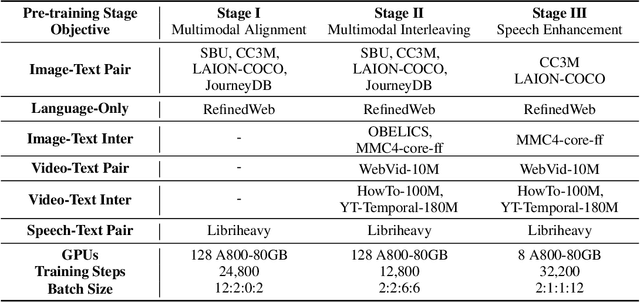

Abstract:In this paper, we introduce MIO, a novel foundation model built on multimodal tokens, capable of understanding and generating speech, text, images, and videos in an end-to-end, autoregressive manner. While the emergence of large language models (LLMs) and multimodal large language models (MM-LLMs) propels advancements in artificial general intelligence through their versatile capabilities, they still lack true any-to-any understanding and generation. Recently, the release of GPT-4o has showcased the remarkable potential of any-to-any LLMs for complex real-world tasks, enabling omnidirectional input and output across images, speech, and text. However, it is closed-source and does not support the generation of multimodal interleaved sequences. To address this gap, we present MIO, which is trained on a mixture of discrete tokens across four modalities using causal multimodal modeling. MIO undergoes a four-stage training process: (1) alignment pre-training, (2) interleaved pre-training, (3) speech-enhanced pre-training, and (4) comprehensive supervised fine-tuning on diverse textual, visual, and speech tasks. Our experimental results indicate that MIO exhibits competitive, and in some cases superior, performance compared to previous dual-modal baselines, any-to-any model baselines, and even modality-specific baselines. Moreover, MIO demonstrates advanced capabilities inherent to its any-to-any feature, such as interleaved video-text generation, chain-of-visual-thought reasoning, visual guideline generation, instructional image editing, etc.
GenMapping: Unleashing the Potential of Inverse Perspective Mapping for Robust Online HD Map Construction
Sep 13, 2024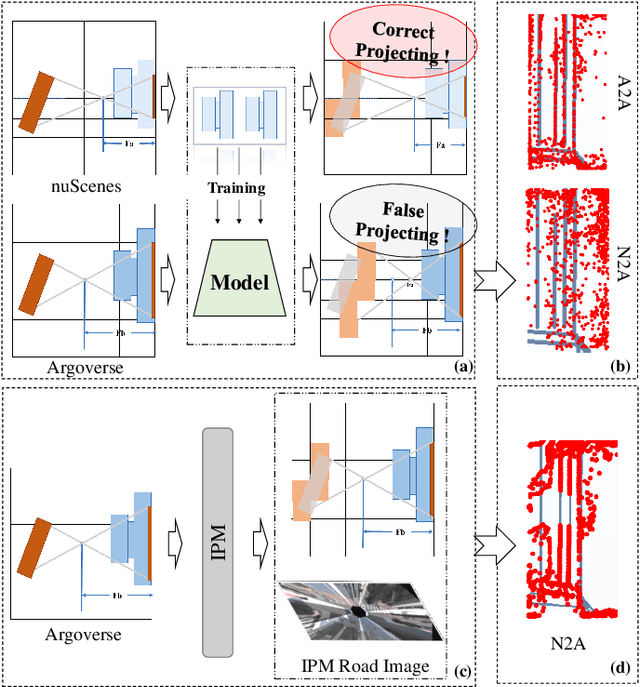
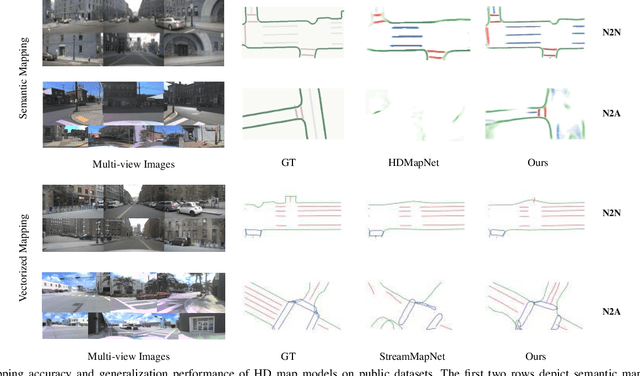
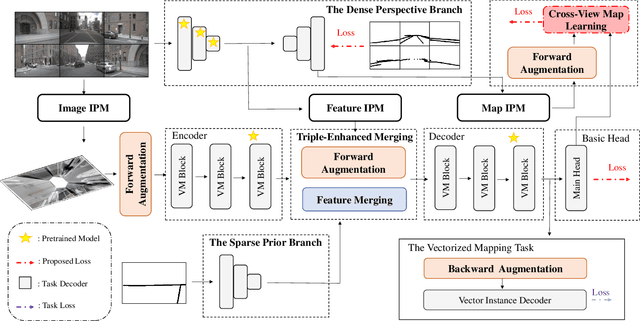
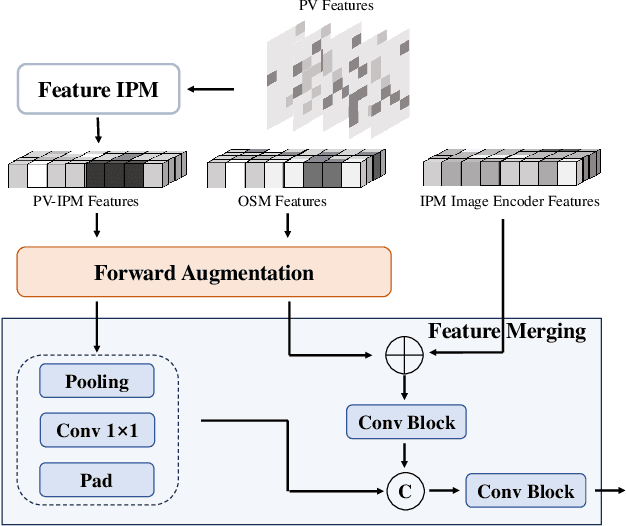
Abstract:Online High-Definition (HD) maps have emerged as the preferred option for autonomous driving, overshadowing the counterpart offline HD maps due to flexible update capability and lower maintenance costs. However, contemporary online HD map models embed parameters of visual sensors into training, resulting in a significant decrease in generalization performance when applied to visual sensors with different parameters. Inspired by the inherent potential of Inverse Perspective Mapping (IPM), where camera parameters are decoupled from the training process, we have designed a universal map generation framework, GenMapping. The framework is established with a triadic synergy architecture, including principal and dual auxiliary branches. When faced with a coarse road image with local distortion translated via IPM, the principal branch learns robust global features under the state space models. The two auxiliary branches are a dense perspective branch and a sparse prior branch. The former exploits the correlation information between static and moving objects, whereas the latter introduces the prior knowledge of OpenStreetMap (OSM). The triple-enhanced merging module is crafted to synergistically integrate the unique spatial features from all three branches. To further improve generalization capabilities, a Cross-View Map Learning (CVML) scheme is leveraged to realize joint learning within the common space. Additionally, a Bidirectional Data Augmentation (BiDA) module is introduced to mitigate reliance on datasets concurrently. A thorough array of experimental results shows that the proposed model surpasses current state-of-the-art methods in both semantic mapping and vectorized mapping, while also maintaining a rapid inference speed. The source code will be publicly available at https://github.com/lynn-yu/GenMapping.
Geo-Llama: Leveraging LLMs for Human Mobility Trajectory Generation with Spatiotemporal Constraints
Aug 25, 2024



Abstract:Simulating human mobility data is essential for various application domains, including transportation, urban planning, and epidemic control, since real data are often inaccessible to researchers due to expensive costs and privacy issues. Several existing deep generative solutions propose learning from real trajectories to generate synthetic ones. Despite the progress, most of them suffer from training stability issues and scale poorly with growing data size. More importantly, they generally lack control mechanisms to steer the generated trajectories based on spatiotemporal constraints such as fixing specific visits. To address such limitations, we formally define the controlled trajectory generation problem with spatiotemporal constraints and propose Geo-Llama. This novel LLM-inspired framework enforces explicit visit constraints in a contextually coherent way. It fine-tunes pre-trained LLMs on trajectories with a visit-wise permutation strategy where each visit corresponds to a time and location. This enables the model to capture the spatiotemporal patterns regardless of visit orders and allows flexible and in-context constraint integration through prompts during generation. Extensive experiments on real-world and synthetic datasets validate the effectiveness of Geo-Llama, demonstrating its versatility and robustness in handling a broad range of constraints to generate more realistic trajectories compared to existing methods.
Group-Control Motion Planning Framework for Microrobot Swarms in a Global Field
Jun 19, 2024



Abstract:This paper investigates how group-control can be effectively used for motion planning for microrobot swarms in a global field. We prove that Small-Time Local Controllability (STLC) in robot positions is achievable through group-control, with the minimum number of groups required for STLC being $\log_2(n + 2) + 1$ for $n$ robots. We then discuss the complexity trade-offs between control and motion planning. We show how motion planning can be simplified if appropriate primitives can be achieved through more complex control actions. We identify motion planning problems that balance the number of robot groups and motion primitives with planning complexity. Various instantiations of these motion planning problems are explored, with simulations to demonstrate the effectiveness of group-control.
ContextBLIP: Doubly Contextual Alignment for Contrastive Image Retrieval from Linguistically Complex Descriptions
May 29, 2024Abstract:Image retrieval from contextual descriptions (IRCD) aims to identify an image within a set of minimally contrastive candidates based on linguistically complex text. Despite the success of VLMs, they still significantly lag behind human performance in IRCD. The main challenges lie in aligning key contextual cues in two modalities, where these subtle cues are concealed in tiny areas of multiple contrastive images and within the complex linguistics of textual descriptions. This motivates us to propose ContextBLIP, a simple yet effective method that relies on a doubly contextual alignment scheme for challenging IRCD. Specifically, 1) our model comprises a multi-scale adapter, a matching loss, and a text-guided masking loss. The adapter learns to capture fine-grained visual cues. The two losses enable iterative supervision for the adapter, gradually highlighting the focal patches of a single image to the key textual cues. We term such a way as intra-contextual alignment. 2) Then, ContextBLIP further employs an inter-context encoder to learn dependencies among candidates, facilitating alignment between the text to multiple images. We term this step as inter-contextual alignment. Consequently, the nuanced cues concealed in each modality can be effectively aligned. Experiments on two benchmarks show the superiority of our method. We observe that ContextBLIP can yield comparable results with GPT-4V, despite involving about 7,500 times fewer parameters.
 Add to Chrome
Add to Chrome Add to Firefox
Add to Firefox Add to Edge
Add to Edge